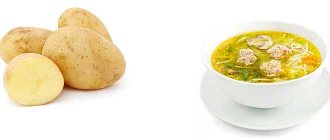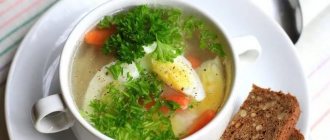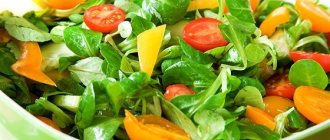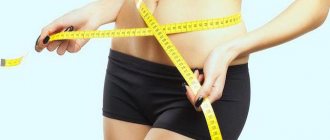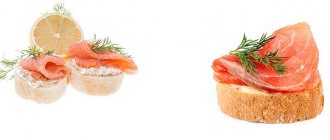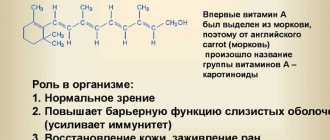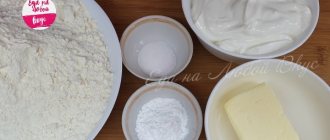Calorie content of vinaigrette with potatoes, beans, green peas, sauerkraut, mayonnaise, vegetable oil.
Weekdays and holidays during the cold season almost always pass with vinaigrette on the table. This salad is so versatile and easy to prepare that it has long won the sympathy of gourmets of all ages.
It has another name - a salad made from everything that was in the refrigerator. Budgeting combined with health benefits are the factors that housewives take into account when diversifying the family’s daily menu.
It is interesting that people who want to lose extra pounds are happy to eat vinaigrette. They just change the composition of the ingredients and count the calories.
Let's talk in more detail about the energy value of 100 g of vinaigrette, depending on its composition.
Calorie content of vinaigrette per 100 grams with vegetable oil and potatoes: value for those losing weight
delicious vinaigrette with butter and potatoes in a bowl
When your goal is to lose weight and gain weight, you have to count the calories of the dishes you eat.
Vinaigrette is an interesting combination of vegetables that can be adjusted according to the energy value of the finished dish.
The classic version consists of boiled potatoes and vegetable oil. They are the highest calorie ingredients.
Therefore, 100 g of vinaigrette with their participation contains approximately 103 kcal.
Ingredients of the vinaigrette
The dish contains the following ingredients:
- cucumbers;
- potato;
- vegetable oil;
- carrot;
- peas;
- beet;
- onion;
- salt.
Thanks to such components in the recipe, the vegetable salad contains a large amount of ascorbic and nicotinic acid, B vitamins, and lipophilic components (vitamin K).
Beneficial substances also include:
- beta-carotene;
- cellulose;
- organic acids.
Vinaigrette has a rich chemical composition consisting of the following minerals:
- gland;
- phosphorus;
- magnesium;
- iodine;
- calcium;
- potassium
Calorie content of vinaigrette per 100 grams with mayonnaise
a portion of aromatic vinaigrette with mayonnaise with several pieces of herring.
Seasoned not with vegetable oil, but with mayonnaise, the vinaigrette significantly adds to the energy value. So 100 g of salad will “heavier” up to 177 kcal.
Calorie content of traditional salad products
A person who, for health reasons or to have a good appearance, is concerned about losing weight can create his own vinaigrette recipe. The energy value of the main and most often found products in this dish is as follows - the numbers are indicated per 100 grams in kilocalories:
- Boiled potatoes – 78;
- Boiled beets – 40;
- Boiled carrots – 35;
- Pickled cucumbers – 15;
- Sauerkraut – 25;
- Peas – 54;
- Boiled beans – 250;
- Salted mushrooms – 26;
- Lightly salted herring – 160–218;
- Sunflower seed oil – 900;
- Mayonnaise – 680.
Nutritionists estimate the calorie content of the vinaigrette, which is prepared from the above products with potatoes and sunflower seed oil, at 120 kcal per hundred grams of the dish, and 50% comes from the dressing. Thus, those who are forced to watch their weight need to think about whether to eat the vinaigrette with an oil dressing, or simply pour it with lemon juice or sprinkle it with vinegar.
Is it possible to eat vinaigrette while losing weight?
It's definitely possible. Just regulate its calorie content by excluding and replacing foods that contribute to the accumulation of excess weight. These are, for example, potatoes, mayonnaise. Worthy and tasty substitutes for them would be:
- Salted mushrooms are a source of protein. It, in turn, is useful in burning excess fat.
- Sauerkraut and pickles.
- Canned peas, beans.
- Vegetable oils - olive, sunflower, flaxseed.
Get examined by a gastroenterologist to see if you have gastritis or an imbalance of acidity in the stomach. Then sauerkraut is allowed in the aromatic salad.
So, we looked at the energy value of a vinaigrette with different ingredients, both vegetable and liquid seasonings. We determined the conditions for consuming the dish for those who want to reduce their weight.
Be healthy!
Possible harm
Consuming a large amount of vinaigrette harms the body and provokes excess weight gain.
The dish contains vegetables (carrots, potatoes, beets) with a high glycemic index, as well as a large amount of carbohydrates that quickly penetrate the bloodstream. As a result, insulin levels increase and the risk of developing diabetes increases.
If the vinaigrette contains pickles and sauerkraut, the salad should be consumed with caution by people with the following diseases:
- kidney pathologies;
- gastritis with high acidity;
- stomach ulcer.
Video: preparing vinaigrette - calorie content of 1 kg of product
- Vinaigrette salad: the best recipes. Classic vinaigrette with peas
- Pickled and canned beets for the winter - the best recipes. How to pickle beets for vinaigrette, borscht for the winter in jars?
- How to quickly cook beets? How long to cook beets for vinaigrette?
- How and how much to cook young potatoes for Olivier salad, vinaigrette?
- Sauerkraut is quick, crispy and very juicy: 7 delicious recipes
- Combination of vegetables and fruits in salad: rules, table
- Diet table No. 8 for obesity: principles, list of allowed and prohibited foods, menu for the week and for every day
- What should be on the festive New Year's table: the best New Year's recipes for holiday appetizers, salads, desserts, meat dishes
- How long can you store boiled beets in the refrigerator?
- Borscht with and without meat: the best recipes.
- Laxative foods, fruits and vegetables for constipation, for weight loss: list, recipes for drinks and dishes with a laxative effect on the intestines.
Potatoes – to be or not to be in vinaigrette
Traditionally, after beets in terms of the number of ingredients in the total volume, potatoes take second place in this salad. This begs the question - is it possible to eat it without potatoes, will it be tasty? The dish got its name thanks to a foreign language - formed by two French words, the name translated means a mixture of vinegar with vegetable oil - this is a dressing for boiled vegetables with pickles. Therefore, the salad has the right to be without potatoes.
Green peas can replace potatoes. To make the salad even more dietary, high-calorie sunflower seed oil can be replaced with flaxseed oil - you only need one or two spoons of it for a large dish. The calorie content of one hundred grams of a dish without potatoes will be only 49 kcal, which means that the salad can be recommended if it is necessary to follow a low-calorie diet.
Step-by-step preparation of a classic vinaigrette
Although this vinaigrette is classic and its recipe remains unchanged, you can prepare a dietary salad in 2 ways.
Ingredients (for 4 servings):
- boiled potatoes – 5 pcs.;
- boiled beets – 2 pcs.;
- boiled carrots – 5 pcs.;
- pickled cucumbers – 4 pcs.;
- 1 onion;
- black pepper, salt - individually.
How to prepare a dietary dish depends only on individual preferences. In any case, potatoes, beets and carrots need to be boiled. They and cucumbers should be cut into cubes, and the onions should be cut into half rings.
Preparation:
- Option. Vegetables (excluding beets) need to be chopped, mixed and seasoned with oil (sunflower, less often olive). The beets are cut and seasoned separately; they should stand for about 5-7 minutes. Only then can the salad components be mixed. This cooking method allows you to highlight the taste of individual vegetables.
- Option. All components are cut, mixed, and only then is it time to season. If you prepare the vinaigrette in this way, it will have a uniform structure and deep red color.
Contraindications
The benefits of the ingredients in the dish are beyond doubt, but there are also some disadvantages. Firstly, when you include sauerkraut, there is a risk of developing problems with the functioning of the digestive system: bloating, colic, flatulence. This has a particularly negative impact on the well-being of people with colitis, gastritis or peptic ulcers. Cucumbers prepared with low-quality vinegar can be no less dangerous. But the main danger of vinaigrette lies in improper storage conditions. For your diet, it is better to use fresh salad. It is not recommended to store it in the refrigerator for more than a day to avoid intestinal disorders.
Absolute contraindications to any weight loss nutrition program using a vegetable mix are:
- diseases of the gastrointestinal tract;
- inflammatory processes in the intestines;
- diabetes;
- pathologies of the kidneys and bile ducts.
Low calorie recipes
Depending on what ingredients will be included in the vinaigrette, you can adjust the calorie content of the dietary dish. Below are the most common options. This does not mean that you need to cook only according to them; you can choose other recipes or prepare a vinaigrette according to your preferences. The main thing is the low calorie content of the salad.
Summer
This delicious salad is truly dietary. Calorie content per 100 grams is only 90 kcal. To prepare the vinaigrette, you will need (calculated for 200 gram portions):
- 2 medium potatoes;
- 2 carrots;
- medium-sized beets - 1 piece;
- 70 g fresh cabbage;
- 2 medium fresh cucumbers;
- tomatoes – 2 pcs.;
- fresh apples – 2 pcs.;
- a medium bunch of onions and the same number of green salad leaves;
- a bunch of dill and parsley;
- 3 tablespoons canned peas;
- 110 g butter;
- 1 tsp. salt.
How to cook. Potatoes, beets and carrots are boiled and cooled separately. They and cucumbers are peeled and cut. Tomatoes are cut into thin slices. Shred lettuce leaves. Mix everything, add salt and add oil. Then everyone gets in the way. The dietary vinaigrette is ready.
No potatoes
Preparing a vinaigrette without potatoes makes an already dietary dish practically calorie-free. There are only 43.8 kcal per 100 g of finished dish. At the same time, the vinaigrette contains proteins, fats and carbohydrates (BJU) in an amount of 1.7/1.2/6.9 g.
To prepare you need:
- 200 g peas (can be frozen or canned);
- the same amount of celery;
- 1 boiled beets;
- 2 carrots;
- 180-220 g sauerkraut;
- 1 tbsp. l. oil (preferably olive);
- 1-2 tbsp. l. lemon juice.
How to prepare:
- If you use canned peas, they are added like this; if they are frozen, they need to be boiled. You need to finely chop the celery and grate the carrots. The beets are cut into cubes.
- The cabbage is washed to remove excess salts.
- Mix the ingredients and season with oil, after which you need to mix them again and add lemon juice.
- Stir the prepared most dietary vinaigrette again.
"Raw"
The name of the dietary dish is due to the presence of raw beets in it. The remaining vegetables are cooked, as with the classic recipe. At the same time, the calorie content is only 47 kcal per 100 g.
Required in grams:
- canned green peas – 250 g;
- sauerkraut – 50 g;
- boiled potatoes – 220 g;
- onions – 70 g;
- cucumbers and carrots - the same amount;
- beets – 230 g.
Preparation. Coarsely grate the beets and sprinkle with lemon juice. Boiled carrots and potatoes, cut cucumbers into small cubes. Finely chop the onion. Mix the ingredients.
Mushroom
An unusual recipe that allows you to colorize your diet. Calorie content for 4 servings – 217 kcal. To prepare the dish, you need to take:
- beets – 1 medium;
- potatoes 2-3 medium root vegetables;
- carrots – 2 pcs.;
- pickled mushrooms – 220 g;
- pickled cucumbers – 1 medium size;
- onion – 1 pc.;
- individually salt and ground black pepper;
- sunflower oil – 2 tbsp. l.;
- lemon – 1 pc.
Boil vegetables and cut into cubes. Cucumbers, onions and mushrooms are chopped. Mix the ingredients and squeeze lemon into them. Add seasonings.
With apple and zucchini
Calorie content – 120 kcal. Ingredients you need to take:
- 250 g zucchini;
- 150 g cucumbers (type is not important);
- apples – 1-2 pcs.;
- fresh zucchini – 1 medium;
- green onions – 100 g;
- olive oil – 30 g;
- vinegar or lemon juice – 15 g;
- arugula and wild garlic pesto – 5-10 g;
- Instead of pesto, you can take 1 garlic clove (passed through a press) and 20 g of small herbs.
How to cook. The dressing is mixed in a salad bowl. Cut the onion into thin rings and pour into the dressing. Do the same with finely diced cucumbers. Apples and zucchini are peeled and finely cut into cubes. Pour into the rest of the vegetables. Stir and add spices. Add oil and place the dish in the refrigerator for 20-30 minutes.
With beans
This dietary salad contains 81.6 kcal per 100 g. The ingredients you will need (calculated for 5 servings):
- 2 potatoes;
- beets – 1 pc.;
- 2 carrots;
- 1 medium onion;
- 2 cucumbers (salted or lightly salted);
- 110 g cabbage (sauerkraut or fresh);
- 350 g beans;
- vegetable oil – 20-30 g;
- salt - individually.
Preparing a dietary dish is simple: boil the vegetables and chop them. The cabbage is washed and the ingredients are mixed and spices are added. Mix everything again. At the end, add canned beans, after draining the liquid.
Low-calorie vinaigrette with beans
An excellent dinner option on healthy nutrition. You will need these ingredients:
- 2 boiled beets. You can also bake it.
- 100 grams of pickled cucumbers.
- 100 grams of boiled beans.
- 2 tablespoons of green peas.
- 50 grams of sauerkraut.
- 1 tablespoon of vegetable oil.
Cut the beets and cucumbers into cubes and mix with the rest of the ingredients. Salt, pepper, season with vegetable oil.
Any of the vinaigrette options can be sprinkled with green onions or any other herbs! Be sure to prepare a vinaigrette and lose weight easily!
Vinaigrette on pp: is it possible or not?
Questions about whether it is possible to eat vinaigrette on a diet have been going on for a very long time.
Some people believe that this dish is not at all dietary and contains many harmful products that are the culprits of extra pounds. Others boldly include vinaigrette in their diet and easily lose weight! Who is right? Let's find out! First, let's repeat the common truths.
People get fat not from any specific foods, but from overeating.
Or, in other words, extra pounds come to us when we eat more calories than we burn. Based on this, then the classic vinaigrette recipe will not harm you at all if you know your KBJU standards and strictly follow them!
But it is worth noting that not everyone is ready to do mathematical calculations, weigh all the products and calculate the calorie content of each prepared dish. In this case, the only way out is to revise the vinaigrette recipe, remove the most high-calorie foods from it and significantly reduce its calorie content.
Let's look at what the vinaigrette consists of and how to make it more dietary, so that you can safely eat it and not worry about your figure.
One of the main “harmful” vinaigrette products is potatoes . Although it must be said in truth that this vegetable does not entirely deserve its title of “harmful”. 100 grams of boiled potatoes contain 82 calories. Compared to the calorie content of boiled carrots (about 35 calories) and boiled beets (49 calories), these figures really look impressive. Therefore, one way to reduce the calorie content of the finished dish is simply not to use potatoes. Thus, reduce the calorie content of the finished dish and will not burden yourself with long calorie calculations.
If you thought that potatoes were the culprit of all the troubles in vinaigrette, then you were deeply mistaken. Let's move on now to the real culprit - vegetable oil.
How many tablespoons of vegetable oil do you put in one serving of vinaigrette?
2−3? Or maybe you just generously drizzle the entire cooked portion and don’t even think about how much vegetable oil you added and how many calories you will have in the finished dish..
Now let's get to the numbers! 1 tablespoon of vegetable oil contains about 120 calories! And 100 grams of ready-made vinaigrette contains about 46 calories!
Now imagine that if you take 200 grams of vinaigrette and season it with 2 tablespoons of oil, how many calories will you have on your plate? Only 96 calories from the vinaigrette itself and a whopping 240 calories from the vegetable oil! And now you've got extra calories. That’s why you need to be very careful when seasoning the vinaigrette with oil.
The ideal option is to prepare a vinaigrette and season it immediately before eating in portions, then this delicious dish will be dietary for you, even if you leave some potatoes in it.
But let's go further and think about it.
How to make pp vinaigrette is not only less calorie, but also healthy, and even better - high in protein.
It's very simple - replace potatoes with beans! This is a great option if you need to prepare a vinaigrette for dinner. Beans are a great source of high-quality protein, so you'll get double the benefits! You can use absolutely any type of bean. If you use ready-made canned beans, then carefully read the composition so that there are no other harmful additives, such as sugar. Of course, the ideal option is to cook the beans yourself.
What to expect from the diet?
As numerous reviews testify, along with the 2-3 kilograms lost during the “vinaigrette diet” (mind you, without debilitating fasting!) As a result of intestinal cleansing, the functioning of the gastrointestinal tract improves, which increases the overall tone of the body.
Vinaigrette is a low-calorie salad.
And the whole secret of this gentle diet lies in the low-calorie content of the vinaigrette.
The average serving of salad is most often 160 or a little more grams, which in kilocalories looks like 90 units, while the daily caloric value for a person who wants to lose weight is 1500 Kcal, not higher.
This partially answers the question of whether it is possible to gain weight with vinaigrette - yes, if you eat it by the bowlful.
You can’t eat to your heart’s content in one sitting, otherwise what kind of diet is this! The volume of one serving should not exceed 300 g.
Calculation of recipe calorie content per 1000 grams
The calculation of the calorie content of 1000 grams of the recipe is based on the summarized indicators of BZhUK (abbreviation: proteins-fats-carbohydrates-acids) of the ingredients from table (1) involved in the preparation. The data was taken from the database of the “products” section of the website and brought into line with the final yield of the dish (net).
Our example involves proteins - 10.8 grams, fats - 101.44 grams and carbohydrates - 62.88 grams contained in 1000 grams of the recipe. Next we perform the calculation:
Energy value of 1000 grams of recipe = 10.8 (proteins)*4 + 101.44 (fats)*9 + 62.88 (carbohydrates)*4 = 43.2 + 912.96 + 251.52 = 1207.7 kcal
Beneficial features
The benefits of vinaigrette for the human body are obvious:
- relieves hunger for a long time;
- using available vegetables for cooking that can be bought at a regular grocery store;
- salad is not prohibited during pregnancy, so if a woman gains a lot of weight, she can maintain it by eating this dish;
- low calorie content allows you to use vinaigrette when losing weight;
- vegetables included in the salad have a beneficial effect on the functioning of the digestive system;
- The salad is rich in vitamins and minerals necessary for the full functioning of the human body.
On a note! Since vinaigrette is a hearty salad, it can be used on a mono-diet. Even if you only eat this dish, you won’t get tired of it soon.
In addition, with regular use of vinaigrette, you can strengthen your nails and hair, stabilize blood pressure, reduce cholesterol levels in the blood, and improve the condition of the skin.
Is salad suitable for weight loss, dieting and PP?
Preparing a vinaigrette is extremely simple, and the ingredients for it can be found at any time of the year. But they are the ones that determine the calorie content, benefits and taste of the salad. You can use vinaigrette both as part of a diet and as a component of your usual diet - the dish is still a dietary one.
The basis of the vinaigrette is vegetables, which makes the composition of the dish optimal not only for weight loss, but also for maintaining an active lifestyle in general. The salad contains a significant amount of vitamins B, A, PP, C and E (the latter has antioxidant properties - it prevents the formation of peroxides that damage cells and cause their premature death). The salad also contains a whole range of essential minerals. The vinaigrette is rich:
- iron;
- zinc;
- magnesium;
- potassium;
- phosphorus;
- copper, etc.
A successful combination of products in a vinaigrette can improve the functioning of the digestive tract and nourish hair, nails, and skin. Also, its regular use will reduce cholesterol and blood pressure.
Considering that most salad recipes contain potatoes (a fairly high-calorie product), the question arises regarding the calorie content in the vinaigrette. Despite this ingredient, vinaigrette is a dietary salad. A standard serving (150 g) contains about 90 kilocalories (kcal). And if you prepare a dish without potatoes, you can make an extremely low-calorie vinaigrette.
Attention! To digest vinaigrette, the body spends significantly more energy than it receives from food. Therefore, it uses alternative energy sources - it breaks down fat deposits.
How much can you save by eating vinaigrette?
By sticking to a diet consisting of vinaigrette, you can get rid of extra pounds without significant effort. This is due to the fact that the salad is not only light and healthy, but also satisfying. However, the severity of the effect depends on the duration and severity of the diet. The toughest option allows you to lose from 2 to 4 kg of excess weight. However, such weight loss requires eating only the most dietary vinaigrette and water for 3-4 days. Such a diet is not only difficult to maintain, but it can be harmful to health.
A more loyal, but also long-term, diet allows you to lose up to 10 kg within 1.5-2 months. To achieve such results, the diet must include other foods, otherwise the harm done to the body will exceed the benefits. The key condition for dietary nutrition is the exclusion of consumption of sweets, flour, fried and fatty foods. It is extremely important to drink at least 1.5-2 liters of liquid per day.
In the dietary diet, daily caloric intake should not exceed 1200 kcal.
Be sure to check out:
Dietary cabbage salad: the best recipes Safe cleansing: flax seeds for weight loss Kefir on a diet: are alternatives possible Competent castling: how to replace high-calorie treats and allergenic foods on a diet
